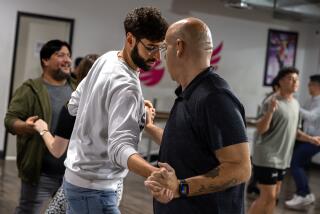DANCE REVIEW : LEWITSKY CO. PRESENTS âFACETSâ
With a rhythmic shimmer of light and a burst of flickering hand-vibrations by two silver-suited dancers, the U.S. premiere of Bella Lewitzkyâs three-part suite âFacetsâ began in Marsee Auditorium of El Camino College on Saturday night.
Commissioned by the Chateauvallon Festival in Southern France, âFacetsâ exploited bold dynamic contrasts and the technical prowess of what is largely a new generation of Lewitzky dancers. However, as in the best Lewitzky choreographies, it also soon developed intriguing emotional and even social implications.
Accompanied by Larry Attawayâs taped score (cascades of metallic percussion layered over high organ tones), Nancy Lanier and Walter Kennedy glittered in the surging first duet. Springy jumps, quivering extended legs, rippling torsos and shifts from flat frontal to supple profile positions evoked the cold, gleaming resilience of a ribbon of stainless steel.
As the music became slow and weighty, Claudia Schneiderman (in florescent pink) and John Pennington (in crimson) flowed through tense gymnastic sequences occasionally relieved by sudden rapid lunges or falls.
The sense of molten lava grew especially vivid in Penningtonâs brilliantly dramatic performance: heroic stretches into extension followed by complete abandonment to being off-balance, volatile arm swings, a dangerous expectancy even in repose. Sometimes Lewitzky heightened his implacable weight and power by having Schneiderman coil under his feet as he walked or turned above her--a rivulet in his wake.
Harsh, isolated sounds and discontinuous passages of assaultive interaction marked the trio for Lori McWilliams and Kenneth B. Talley (wearing combinations of purples and greens)--a sequence as familiar and nasty as broken glass.
Colliding and contending in jagged, unpredictable slashes of movement, they were rather quickly supplanted by a unison finale that involved them with the previous couples and dance vocabularies. But, beyond formal ingenuity, this recapitulation had no new conceptual insights to offer.
Worse, it avoided confronting the disturbing issues of that nihilistic trio--the urban violence and the mindless rage behind it that seemed to be inspiring Lewitzky to a new, raw contemporaneity.
Obviously, at 71 (Tuesday), she isnât the most likely choreographer to dump modern dance in favor of butoh . But the heat and conviction of the trio suggested that doors are opening for her--doors that donât lead to the neat and cozy cast reunion at the end of âFacets.â
Completing the program were the whimsical â8 Dancers/8 Lightsâ (1985, music by Donald Knaack) and the intense âFiveâ (1974, music by Max Lifchitz), familiar explorations of the same spatial problem: dancing behind and between fixed vertical objects.
In the newer work, the dancers bounded cheerily through a forest of neon tubes. In the older one, they vented private anguish in rooms defined by hanging scrim panels and then emerged for happy relationships in the wide open spaces. Each featured highly resourceful transformations of blocked paths into limitless dancer-causeways.
Darleen Neelâs decors and lighting greatly enhanced both works, and the Lewitzky dancers executed them with a special drive and urgency.
More to Read
The biggest entertainment stories
Get our big stories about Hollywood, film, television, music, arts, culture and more right in your inbox as soon as they publish.
You may occasionally receive promotional content from the Los Angeles Times.










